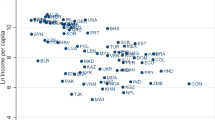Abstract
Rich countries trade more among themselves than with poor economies due to a closer match of exporter supply structures and importer preferences. In the literature, the closeness of supply and demand has traditionally been determined by the quality of products—as expressed in the Linder hypothesis. This paper examines an extension of the hypothesis by considering the extent of brand differentiation as another determinant of the closeness of supply and demand. The analysis employs information on international trademark registrations to test whether richer countries import more from countries exporting products of higher quality and greater brand differentiation. The hypothesis is confirmed in most consumer goods sectors.
Similar content being viewed by others
References
Akerlof, G. A. (1970). The Market for Lemons: Qualitative Uncertainty and the Market Mechanism. Quarterly Journal of Economics (84) (3): 488–500.
Allegrezza, S., and A. Guard-Rauchs (1999). The Determinants of Trademark Deposits: An Econometric Investigation (A Case Study of the BENELUX). Economie Appliquée 52 (2): 51–68.
Anderson, J. E. (1979). A Theoretical Foundation for the Gravity Equation. American Economic Review 69 (1): 106–116.
Anderson, J. E., and E. van Wincoop (2003). Gravity with Gravitas: A Solution to the Border Puzzle. American Economic Review 93 (1): 170–192.
Baroncelli, E., C. Fink, and B. S. Javorcik (2005). The Global Distribution of Trademarks: Some Stylized Facts. The World Economy, forthcoming.
Bergstrand, J. H. (1985). The Gravity Equation in International Trade: Some Microeconomic Foundations and Empirical Evidence. Review of Economics and Statistics 67 (3): 474–481.
Bergstrand, J. H. (1989). The Generalized Gravity Equation, Monopolistic Competition, and the Factor-Proportions Theory in International Trade. Review of Economics and Statistics 71 (1): 143–153.
Bradford, S. (2003). Paying the Price: Final Goods Protection in OECD Countries. Review of Economics and Statistics 85 (1): 24–37.
Deardorff, A. V. (1998). Determinants of Bilateral Trade: Does Gravity Work in a Neoclassical World? In J. A. Frankel (ed.), The Regionalization of the World Economy. Chicago: The University of Chicago Press.
Falvey, R., and H. Kierzkowski (1987). Product Quality, Intra-Industry Trade and Imperfect Competition. In H. Kierzkowski (ed.), Protection and Competition in International Trade. Oxford: Basil Blackwell.
Fink, C., A. Mattoo, and I. C. Neagu (2002). Assessing the Impact of Communication Costs on International Trade. World Bank Policy Research Working Paper 2929. The World Bank, Washington, D.C.
Flam, H., and E. Helpman (1987). Vertical Product Differentiation and North-South Trade. American Economic Review 77 (5): 810–822.
Grossman, G. M., and E. Helpman (1991). Innovation and Growth in the Global Economy. Cambridge, Mass.: MIT Press.
Hallak, J. C. (2001). The Effect of Cross-Country Differences in Product Quality on International Trade Flows. Mimeo. Harvard University.
Helpman, E., and P. R. Krugman (1985). Market Structure and Foreign Trade: Increasing Returns, Imperfect Competition, and the International Economy. Cambridge, Mass.: MIT Press.
Hummels, D. (1999). Towards a Geography of Trade Costs. Mimeo. University of Chicago.
Hummels, D., and P. J. Klenow (2002). The Variety and Quality of a Nation’s Trade. NBER Working Paper 8712. National Bureau of Economic Research, Cambridge, Mass.
Interbrand (2004). Brands and Branding. www.interbrand.com.
Klein, B., and K. B. Leffler (1981). The Role of Market Forces in Assuring Contractual Performance. Journal of Political Economy 89 (4): 615–641.
Leamer, E., and J. Levinsohn (1995). International Trade Theory: The Evidence. In G. Grossman and K. Rogoff (eds.), Handbook of International Economics. Vol. 3. Amsterdam: Elsevier.
Linder, S. B. (1961). An Essay on Trade and Transformation. Uppsala: Almqvist & Wiksell.
Maskus, K. E., and Y. Chen (2002). Vertical Price Control and Parallel Imports: Theory and Evidence. Pacific Economic Review 7 (2): 319–334.
Murphy, K. M., and A. Shleifer (1997). Quality and Trade. Journal of Development Economics 53 (1): 1–15.
Nelson, P. (1970). Information and Consumer Behavior. Journal of Political Economy 78 (2): 311–329.
Rauch, J. E. (1999). Networks versus Markets in International Trade. Journal of International Economics 48 (1): 7–35.
Redding, S., and A. J. Venables (2004). Economic Geography and International Inequality. Journal of International Economics 62 (1): 53–82.
Schott, P. (2001). Do Rich and Poor Countries Specialize in a Different Mix of Goods? NBER Working Paper 8492. National Bureau of Economic Research, Cambridge, Mass.
Schmalensee, R. (1978). A Model of Advertising and Product Quality. Journal of Political Economy 86 (3): 485–503.
Shapiro, C. (1982). Consumer Information, Product Quality, and Seller Reputation. The Bell Journal of Economics 13 (1): 20–35.
Smarzynska, B. (2001). Does Relative Location Matter for Bilateral Trade Flows? An Extension of the Gravity Model, Journal of Economic Integration 16 (3): 379–398.
Soloaga, I., and L. A. Winters (1999). How Has Regionalism in the 1990s Affected Trade? World Bank Policy Research Working Paper 2156. The World Bank, Washington, D.C.
Stokey, N. L. (1991). The Volume and Composition of Trade Between Rich and Poor Countries. The Review of Economic Studies 58 (1): 63–80.
Author information
Authors and Affiliations
Corresponding author
Additional information
JEL no.
F 10, O 34
About this article
Cite this article
Fink, C., Smarzynska Javorcik, B. & Spatareanu, M. Income-Related Biases in International Trade: What Do Trademark Registration Data Tell Us?. Rev. World Econ. 141, 79–103 (2005). https://doi.org/10.1007/s10290-005-0016-x
Issue Date:
DOI: https://doi.org/10.1007/s10290-005-0016-x




